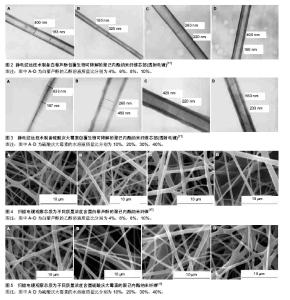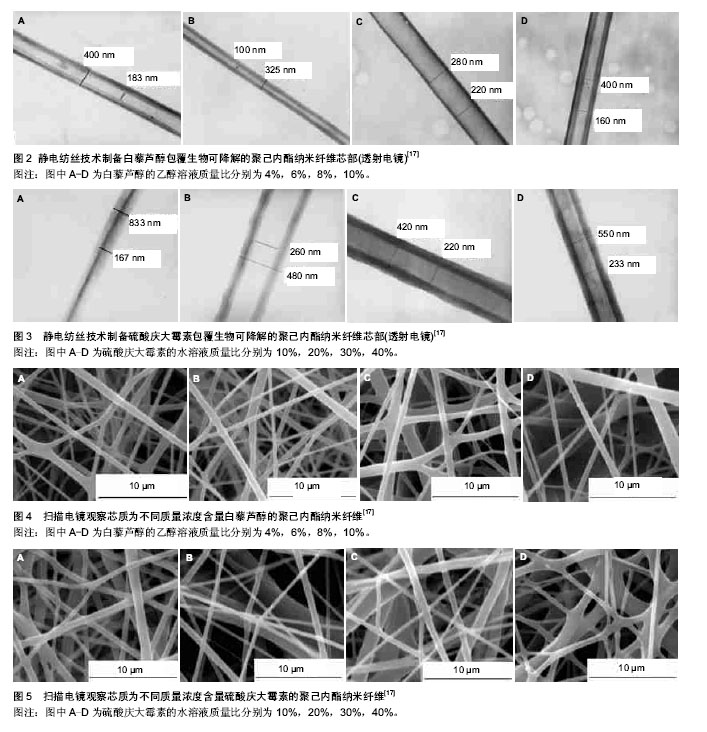Chinese Journal of Tissue Engineering Research ›› 2014, Vol. 18 ›› Issue (12): 1951-1956.doi: 10.3969/j.issn.2095-4344.2014.12.024
Previous Articles Next Articles
Electrospinning technology in tissue engineering: how far is it from the successful application in biomedicine?
Cui Zhi-dong, Li Dong-song, Liu Jian-guo
- Department of Joint Surgery, Norman Bethune No.1 Hospital of Jilin University, Changchun 130021, Jilin Province, China
-
Revised:2014-03-02Online:2014-03-19Published:2014-03-19 -
Contact:Liu Jian-guo, Chief physician, Professor, Doctoral supervisor, Department of Joint Surgery, Norman Bethune No.1 Hospital of Jilin University, Changchun 130021, Jilin Province, China -
About author:Cui Zhi-dong, Studying for master’s degree, Physician, Department of Joint Surgery, Norman Bethune No.1 Hospital of Jilin University, Changchun 130021, Jilin Province, China
CLC Number:
Cite this article
Cui Zhi-dong, Li Dong-song, Liu Jian-guo. Electrospinning technology in tissue engineering: how far is it from the successful application in biomedicine?[J]. Chinese Journal of Tissue Engineering Research, 2014, 18(12): 1951-1956.
share this article

2.1 传统静电纺丝技术在合成聚合物和天然聚合物合成中的应用 组织工程原材料的选择依赖于所需支架的类型,再生组织的性质和再生时间。良好的支架材料能够满足特殊应用条件下所需的特定机械性能和降解时间。目前已有多种天然聚合物和合成聚合物通过静电纺丝技术纺成纤维。鉴于对材料提出的这些必备条件,一些新颖的生物材料例如聚己内酰胺,聚乳酸和它们的共聚物曾被被电纺出来。静电纺丝纳米纤维支架最重要的特性是模仿细胞外基质,为神经细胞再生提供合适生长环境,对支架表面修饰后可以通过控制生物化学信号的变化来调控细胞黏附、迁移、增殖等生物学行为[2]。静电纺丝纳米纤维支架的另一个重要特性是具有高比表面积,这一特性可以使支架携带并释放药物、蛋白、核酸等多种生物化学物质,同时高比表面积增加了细胞和纤维的接触面积,使细胞能更好地吸收这些物质,从而调控细胞生物学行为[3-6]。另外纳米纤维支架具有高渗透性,有利于营养物质、渗透及细胞摄取和代谢产物排出[7-8]。Piskin等[9]回顾了这些聚合物的电纺加工条件,并给出了它们的电纺参数。回顾结果表明:实际上,任一可生物降解和可生物相容的热塑性聚合物电纺已不再是一个难题。通过调整电纺参数,例如电压、电极间的距离、进料速率、聚合物溶液的性质(黏度和导电性)等,大部分热塑材料都能被电纺。许多细胞像间质干细胞、神经干细胞、角蛋白细胞、心肌细胞、软骨细胞、表皮细胞等与电纺后的热塑材料具有良好生物相容性。 与合成聚合物相比,天然聚合物具有较好的生物相容性并能提供细胞吸附和增殖所需的许多有益成分,但很难对它们进行加工,需要对其进行改性才能进行更好的电纺。Skotak等[10]通过改变壳聚糖的可溶性来改善其电纺的可加工性,这种方法是通过化学改性实现的。壳聚糖衍生物经由开环聚合作用接枝L-乳酸低聚物,这会改善壳聚糖在不同有机溶剂的溶解度及它的降解速率和亲水性,有利于电纺的加工合成。天然聚合物电纺的另一个问题就是这些纳米纤维的一部分需要交联来维持它们的纤维形状。Matsuda等[11]制备出了非水溶性壳聚糖纳米纤维膜和管,并且用28%氨基酸水溶液交联,该方法提高了电纺材料的热稳定性,并能提升其机械性能。研究者一致认为天然聚合物与合成聚合物与的结合不但有助于改变天然高分子的溶解度还有助于其改性,这种结合能把合成高分子的独特性能与天然高分子的生物功能相结合。壳聚糖本来很难被电纺成纳米纤维,而通过添加一小部分的聚乳酸聚丙基酰胺共聚物就能很容易地电纺[12]。电纺纤维直径取决于高分子的浓度及壳聚糖与聚乳酸聚丙基酰胺共聚物的混合比例。当壳聚糖与聚乳酸聚丙基酰胺共聚物质量含量之比是1∶2时,在纳米纤维毡上可以观察到最多的细胞增殖。李海滨等[13]直接从家蚕中部丝腺提取丝胶蛋白与聚己内酯结合起来,制备成综合两者优点的聚己内酯/丝胶蛋白纳米纤维支架,FEK4细胞体外培养显示其在纳米纤维上的黏附情况良好,并且与纤维紧密相连,说明此材料的细胞亲和性良好。 在骨组织工程方面,Kim等[14]应用明胶-羟基磷灰石纳米电纺纤维模拟人骨基质来引导骨的再生。他们将羟基磷灰石沉淀物与明胶基体冻干,溶入有机溶剂,然后进行电纺。与纯明胶相比,混入了羟基磷灰石的明胶纳米材料能改善骨源性细胞的活性。在组织工程应用中,天然聚合物和合成聚合物的传统静电纺丝技术已相对成熟,对于其相关参数的确定已基本成型,通过该项技术可以将有机合成高分子材料与天然材料相互结合,使合成后的材料具有更加优越的组织工程特性,例如良好的生物相容性,更大的机械强度,便于加工等优点。 2.2 改进的静电纺丝技术在组织工程中的应用 最近,在传统的电纺技术基础上,一些新的电纺技术被开发出来,并应用到组织工程支架制备当中。传统的复合纤维由于两种材料很少能同时溶解于同一溶剂,而同轴电纺技术则解决了这一问题,它不但可以满足不同材料的混合电纺,同时其独特的芯-壳结构为支架提供了更好的机械性能和生长环境,一方面其芯材料可以随着壳材料的降解而逐渐释放,同时也可以用于药物释控的应用。同轴电纺技术不但适用于包囊生物相关性分子和纳米复合物,而且对于电纺纤维的表面改性也非常实用。Sun等[15]第1次报道用同轴电纺制备了芯/壳结构的纳米纤维。Zhang等[16]利用这种同轴电纺技术研究纳米纤维涂层对细胞增殖行为的影响。他们制备了涂有胶原的聚己内酯纳米纤维。研究显示聚己丙酰胺上的胶原涂层有利于人表皮成纤维细胞的增殖,并能促进细胞在支架内部的迁移。同济大学的黄争鸣等[17]采用同轴静电纺丝法,将药物硫酸庆大霉素和白藜芦醇分别作为可生物降解的聚己内酯纳米纤维的核,制备得到的核-壳结构复合纳米纤维有望应用于外科手术的缝合线,伤口包覆材料等(图2-5)。 乳液静电纺丝相对于同轴静电纺丝可控性更好,应用领域更广泛,且在制备含有活性物质、特殊药物及其他功能纤维方面有着特殊的意义。乳液静电纺丝技术是近10 年来发展的制备“芯-壳”超细纤维结构的方法。当外相为疏水的高分子有机溶剂、内相为药物水溶液时,制备所得纤维的疏水外壳能够控制水溶性药物的释放。其特点为只需采用常见的单孔针头即可进行纺丝,但是要加入能使体系较长时间稳定的乳化剂。已有文献报道,乳化剂为离子型表面活性剂,有一定毒性。王浩等[18]采用生物相容性好且可降解的聚乙二醇嵌段聚ε-己内酯为油包水型乳化剂,借助药物本身的表面活性性质辅助其乳化,制备得到了稳定时间较长的可纺W/O(水包油型)乳液。 无功静电纺丝是另一种改良技术,该技术将静电纺丝和交联同时进行[19]。Ji等[19]报道利用无功静电纺丝方法制备了相互交联的透明质酸水凝胶纳米纤维,应用于组织工程支架的制备。利用一种双泵混合技术将甲巯基羟基磷灰石衍生物,3,3-二硫代二(丙酸二酰肼)修饰的羟基磷灰石(HA-DTPH)和聚(乙二醇)双丙烯酸酯相互交联。使交联反应在静电纺丝加工过程中同时发生。经细胞形态学研究观察发现,在吸附了纤维连接蛋白的羟基磷灰石纳米纤维支架上,NIH3T3成纤维细胞能通过纳米纤维网络迁移到支架内部,并在其内部建立精细的三维树枝状的形态结构。 Kidoaki等[20]首次报道了层层静电纺丝。在层层静电纺丝中,把每种聚合物溶液电纺,形成它们自己单独的一层,接着用相同的目标接收器接收。为了实现引导骨再生膜的机械稳定性,Fujihara等[21]将复合纳米纤维聚丙基稀酰胺/碳酸钙纺到聚丙基稀酰胺纳米纤维膜上,使材料具有较高的拉伸强度,该材料实际上包含两层膜,即一个功能层和一个机械支持层。用这种方法,细胞在静电纺丝纳米纤维的协助下能均匀一致地组装成多层三维结构,精确控制纤维层的厚度、纤维直径和纤维定位,同样包括生物活性分子进入每层纤维。 通过对传统静电纺丝技术系统的改良来制备有序的纤维结构或排列。在支架上的定位可能会影响细胞增殖,而静电纺丝能很容易地控制细胞定位和组织生长。Lee 等[22]研究了模拟天然纤维的支架,进一步证实纤维排列的作用。在研究中他们考察了用静电纺丝制备基于聚己内 酯/胶原的纳米纤维,作为可植入工程肌的支架系统的可行性。用聚己内酯和胶原的混合物通过静电纺丝制备了不同纤维方向的纳米纤维。人骨骼肌细胞种植到静电纺丝的聚己内酯/胶原纳米纤维网上,并分析细胞黏附、增殖和机构形成。结果显示与随机排列的纳米纤维相比,单方向排列的纳米纤维能显著地诱导肌细胞排列和肌管的形成。 李好义等[23]研究组发明了一种结合静电纺丝和快速成型技术的新方法,有望为静电纺丝在组织工程中的应用带来新突破,其基本思想就是利用纳米级纤维的静电纺丝设备,结合快速成型中的精密接收装置,获得任意想要的三维立体结构,有望实现对纤维直径、支架孔隙率和孔径、纤维形态的动态实时控制。最近研究报道了一种拓展的静电纺丝技术,即将聚合物溶液与低分子质量金属化合物(或原位生成的低分子质量金属化合物)均匀混合后,先利用静电纺丝制备出以聚合物为载体的纳米纤维,然后用高温烧结去除聚合物载体制备出陶瓷或金属纳米纤维[24]。"

| [1] 王德诚.静电纺丝的技术进展[J].合成纤维工业,2009,32(2): 42-43. [2] Plant AL,Bhadriraju K,Spurlin TA,et al.Cell response to matrix mechanics: focus on collagen. Biochim Biophys Acta.2009; 1793(5):893-902. [3] Luu YK,Kim K,Hsiao BS,et al.Development of a nanostructured DNA delivery scaffold via electrospinning of PLGA and PLA-PEG block copolymers. J Control Release. 2003;89(2):341-353. [4] De Nicola AF,Labombarda F,Deniselle MC,et al.Progesterone neuroprotection in traumatic CNS injury and motoneuron degeneration. Front Neuroendocrinol.2009;30(2): 173-187. [5] Li C,Vepari C,Jin HJ,et al.Electrospun silk-BMP-2 scaffolds for bonetissue engineering. Biomaterials. 2006;27(16): 3115-3124. [6] [Wang YC,Wu YT,Huang HY,et al.Sustained intraspinal delivery of neurotrophic factor encapsulated in biodegradable nanoparticles following contusive spinal cord injury. Biomaterials. 2008;29(34):4546-4553. [7] Ashammakhi N,Ndreu A,Yang Y,et al.Tissue engineering: A new take-off using nanofi ber-based scaffolds.J Craniofac Surg.2007;18(1):3-17. [8] Chew SY,Wen Y,Dzenis Y,et al.The role of electrospinning in the emerging field of nanomedicine.Curr Pharm Des.2006; 12(36):4751-4770. [9] Piskin E,Bolgen N,Egri S,et al.Electrospun matrices made of poly(alpha-hydroxy acids) for medical use.Nanomedicine. 2007;2(4):441-457. [10] Skotak M,Leonov AP,Larsen G,et al.Biocompatible and biodegradable ultrafine fibrillar scaffold materials for tissue engineering by facile grafting of L-lactide onto chitosan.Biomacromolecules.2008;9(7):1902-1908. [11] Matsuda A,Kagata G,Kino R,et al.Preparation of chitosan nanofiber tube by electrospinning.J Nanosci Nanotechnol. 2007;7(3):852-855. [12] Chen F1,Li X,Mo X,et al.Electrospun chitosan-P(LLA-CL) nanofibers for biomimetic extracellular matrix.J Biomater Sci Polym Ed.2008(5):19,677-691. [13] 李海滨,李林昊,杨力,等. PCL/ SS 纳米纤维支架的制备及相容性研究[J].生物医学工程学杂志,2011,28(2):305-309. [14] Kim HW,Song JH,Kim HE.Nanoriber generation of gelatin-hydroxyapatite biomimetics for guided tissue regeneration.Adv Funct Biol.2005;15(12): 1988-1994. [15] Sun ZC,Zussman E,Yarin AL,et al.Compound core-shell polymer nanofibers by co-electrospinning.Adv Mater.2003; 15(22):1929. [16] Zhang YZ,Venugopal J,Huang ZM,et al.Characterization of the surface biocompatibility of the electrospun PCL-collagen nanofibers using fibroblasts. Biomacromolecules. 2005;6(5): 2583-2589. [17] 黄争鸣,杨爱昭.将源药包覆到聚己内酯超细纤维的芯部[J].高分子学报,2006,50(1): 48-52. [18] 王浩,丁怀伟,温梦,等. L-肉毒碱复合聚乙二醇-b-聚ε-己内酯纤维的W/O 乳液电纺制备及表征[J].沈阳药科大学学报,2013, 30(1):1-7. [19] Ji Y,Ghosh K,Li B,et al.Dual-Syringe Reactive Electrospinning of Cross-Linked Hyaluronic Acid Hydrogel Nanofibers for Tissue Engineering Applications. Macromol Biosci. 2006; 6(10): 811-817. [20] Kidoaki S,Kwon IK,Matsuda T.Mesoscopic spatial designs of nano- and microfiber meshes for tissue-engineering matrix and scaffold based on newly devised multilayering and mixing electrospinning techniques.Biomaterials. 2004;26(1):37-46. [21] Fujihara K,Kotaki M,Ramakrishna S.Guided bone regeneration membrane made of polycaprolactone/calcium carbonate composite nano-fibers.Biomaterials. 2005;26(19): 4139-4147. [22] Choi JS,Lee SJ,Christ GJ,et al.The influence of electrospun aligned poly(-caprolactone)/collagen nanofiber meshes on the formation of self-aligned skeletal muscle myotubes. Biomaterials. 2008;29(19):2899-2906. [23] 李好义,刘勇,何雪涛,等.应用于组织工程支架制备的电纺技术[J].生物工程学报,2012, 28(1):15−25. [24] Chronakis IS.Novel nanocomposites and nanoceramics based on polymer nanofibers using electrospinning process: A review.J Mater Process Tech.2005;167:283-193. [25] Ghasemi-Mobarakeh L,Morshed M,Karbalaie K,et al. Electrospun Poly (ε-Caprolactone) Nanofiber Mat as Extracellular Matrix.Yakhteh Med.2008; 10(2):179-183. [26] Ekaputra AK,Prestwich GD,Cool SM,et al.Combining electrospun scaffolds with electrosprayed hydrogels leads to three-dimensional cellularization of hybrid constructs. Biomacromolecules.2008;9(8):2097-2103. [27] Moroni L,Schotel R,Hamann D,et al.3D fiber-deposited electrospun integrated scaffolds enhance cartilage tissue formation.Adv Funct Mater.2008;18(1):53-60. [28] Yang X,Shah JD,Wang H.Nanofiber Enabled Layer-by-Layer Approach Toward Three-Dimensional Tissue Formation. Tissue Eng A.2009;15(4):945-956. [29] Choi S,Lee S,Joo C,et al.Formation of interfiber bonding in electrospun poly(etherimide) nanofiber web.Mater Sci. 2004; 39(4):1511-1513. [30] You Y,Lee SW,Lee SJ,et al.Thermal interfiber bonding of electrospun poly(L-lactic acid) nanofibers.Mater Lett. 2006; 60(11):1331-1333. [31] Erisken C,Kalyon DM,Wang H.Functionally graded electrospun polycaprolactone and beta-tricalcium phosphate nanocomposites for tissue engineering applications. Biomaterials.2008;29(30):4065-4073. [32] Du J,Hsieh YL.Facile aqueous synthesis and growth mechanism of CdTe nanorods. Nanotechnology. 2008;19(44): 1-4. [33] Stoiljkovic A,Ishaque M,Justus U,et al.Preparation of water-stable submicron fibers from aqueous latex dispersion of water-insoluble polymers by electrospinning. Polymer. 2007; 48(14):3974-3981. [34] Dalton PD, Klinkhammer K,M?ller M,et al.Direct in vitro electrospinning with polymer melts. Biomacromolecules. 2006; 7(3):686-690. |
| [1] | Zhang Tongtong, Wang Zhonghua, Wen Jie, Song Yuxin, Liu Lin. Application of three-dimensional printing model in surgical resection and reconstruction of cervical tumor [J]. Chinese Journal of Tissue Engineering Research, 2021, 25(9): 1335-1339. |
| [2] | Zeng Yanhua, Hao Yanlei. In vitro culture and purification of Schwann cells: a systematic review [J]. Chinese Journal of Tissue Engineering Research, 2021, 25(7): 1135-1141. |
| [3] | Xu Dongzi, Zhang Ting, Ouyang Zhaolian. The global competitive situation of cardiac tissue engineering based on patent analysis [J]. Chinese Journal of Tissue Engineering Research, 2021, 25(5): 807-812. |
| [4] | Wu Zijian, Hu Zhaoduan, Xie Youqiong, Wang Feng, Li Jia, Li Bocun, Cai Guowei, Peng Rui. Three-dimensional printing technology and bone tissue engineering research: literature metrology and visual analysis of research hotspots [J]. Chinese Journal of Tissue Engineering Research, 2021, 25(4): 564-569. |
| [5] | Chang Wenliao, Zhao Jie, Sun Xiaoliang, Wang Kun, Wu Guofeng, Zhou Jian, Li Shuxiang, Sun Han. Material selection, theoretical design and biomimetic function of artificial periosteum [J]. Chinese Journal of Tissue Engineering Research, 2021, 25(4): 600-606. |
| [6] | Liu Fei, Cui Yutao, Liu He. Advantages and problems of local antibiotic delivery system in the treatment of osteomyelitis [J]. Chinese Journal of Tissue Engineering Research, 2021, 25(4): 614-620. |
| [7] | Li Xiaozhuang, Duan Hao, Wang Weizhou, Tang Zhihong, Wang Yanghao, He Fei. Application of bone tissue engineering materials in the treatment of bone defect diseases in vivo [J]. Chinese Journal of Tissue Engineering Research, 2021, 25(4): 626-631. |
| [8] | Zhang Zhenkun, Li Zhe, Li Ya, Wang Yingying, Wang Yaping, Zhou Xinkui, Ma Shanshan, Guan Fangxia. Application of alginate based hydrogels/dressings in wound healing: sustained, dynamic and sequential release [J]. Chinese Journal of Tissue Engineering Research, 2021, 25(4): 638-643. |
| [9] | Chen Jiana, Qiu Yanling, Nie Minhai, Liu Xuqian. Tissue engineering scaffolds in repairing oral and maxillofacial soft tissue defects [J]. Chinese Journal of Tissue Engineering Research, 2021, 25(4): 644-650. |
| [10] | Xing Hao, Zhang Yonghong, Wang Dong. Advantages and disadvantages of repairing large-segment bone defect [J]. Chinese Journal of Tissue Engineering Research, 2021, 25(3): 426-430. |
| [11] | Chen Siqi, Xian Debin, Xu Rongsheng, Qin Zhongjie, Zhang Lei, Xia Delin. Effects of bone marrow mesenchymal stem cells and human umbilical vein endothelial cells combined with hydroxyapatite-tricalcium phosphate scaffolds on early angiogenesis in skull defect repair in rats [J]. Chinese Journal of Tissue Engineering Research, 2021, 25(22): 3458-3465. |
| [12] | Wang Hao, Chen Mingxue, Li Junkang, Luo Xujiang, Peng Liqing, Li Huo, Huang Bo, Tian Guangzhao, Liu Shuyun, Sui Xiang, Huang Jingxiang, Guo Quanyi, Lu Xiaobo. Decellularized porcine skin matrix for tissue-engineered meniscus scaffold [J]. Chinese Journal of Tissue Engineering Research, 2021, 25(22): 3473-3478. |
| [13] | Mo Jianling, He Shaoru, Feng Bowen, Jian Minqiao, Zhang Xiaohui, Liu Caisheng, Liang Yijing, Liu Yumei, Chen Liang, Zhou Haiyu, Liu Yanhui. Forming prevascularized cell sheets and the expression of angiogenesis-related factors [J]. Chinese Journal of Tissue Engineering Research, 2021, 25(22): 3479-3486. |
| [14] | Liu Chang, Li Datong, Liu Yuan, Kong Lingbo, Guo Rui, Yang Lixue, Hao Dingjun, He Baorong. Poor efficacy after vertebral augmentation surgery of acute symptomatic thoracolumbar osteoporotic compression fracture: relationship with bone cement, bone mineral density, and adjacent fractures [J]. Chinese Journal of Tissue Engineering Research, 2021, 25(22): 3510-3516. |
| [15] | Liu Liyong, Zhou Lei. Research and development status and development trend of hydrogel in tissue engineering based on patent information [J]. Chinese Journal of Tissue Engineering Research, 2021, 25(22): 3527-3533. |
| Viewed | ||||||
|
Full text |
|
|||||
|
Abstract |
|
|||||